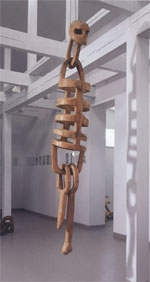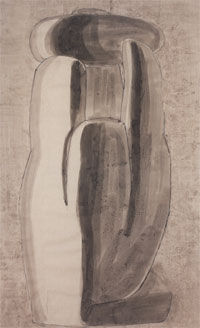Paper Works by Antanas Moncys
Uddrag fra biografi om Antanas Moncys, udgivet af artseria, 2003
Antanas Moncys (1921-1993) was an indefatigable artist: to make his sculpture pieces, he hewed wood and chiseled stone, still others he cast in lead or modeled in clay, he also shaped forms in iron. An avid draughtsman, he also painted, made collages and mosaic, tried his hand in jewellry, designed graveyard memorials, did stage designs, and assembled masks of discarded objects. He crafted tables, lamps and fireplace utensils, and painted Easter eggs. Having discovered his talents in his childhood, the artist once put it, that "he was born to become a sculptor."(...)
He departed Lithuania in October 1944, fleeing the approaching Soviet Army. Pursued by exploding bombs, facing risk in every step, he set off with no destination across Germany (...)
In 1947-1950, Moncys studied sculpture at École des Arts et Métiers in the French-occupied zone of Fribourg (...) Moncys was rewarded for his talent and persistence: he received a scholarship to study in Paris. (...)
October 1950, Paris...
Moncys is searching for the place to study, probing different academies and sculpture studios. Finally, he comes across Ossip Zadkine's (1890-1967) studio at the Académie de la Grande Chaumière....Moncys liked Zadkine's liberal style of instruction, as it allowed students a free interpretation of tasks and encouraged them to work independently.... He left the studio enchanted by the possibilities offered by Modernist treatment of form and having mastered the skills of the craft.
Fifteen years of the artist's career were spent working in a basement studio in a monastery in Paris on Rue de Sevré, where he settled in 1958. It was the time when his art came to flourish. The sculptor was eager to try all kinds of material and explore simultaneously several motifs; he wished his art to embrace the dark and the bright side of the world. The Passion of Jesus Christ, other Biblical themes, human faces, mother and child, family, plants, birds and animals, devil and thinker, little shepherds - everything seemed to be so close to the heart and deserved to be captured in sculptural forms.

Moncys never made abstract sculpture and never had such a goal. He deemed forms beyond representation to be powerless to articulate a message. Eliminating detail, he strove to preserve a uniform, structurally organized plastic form with a wide field of association....
Paris atmosphere was a source of inspiration and a yardstick for the artist's progress. His sculptures of the period from the 1950s through the 1970s manifest the influence of the first part of the 20th century as well as of his own times....
"I did not make my sculptures. I conceived them." These words of the sculptor perfectly fit his "skeleton", "gaunt" re-arrangeable sculptures hewed from wood. It was a new phase of his art, marked by more energy, emphasizing the element of surprise...
It allows variations of the sculpture piece, as its powerful forms can be moved around in space and the rhythm of its masses re-orchestrated.
Stone and wood became his best friends in the 1970s and 1980s. Wood sculpture was a perfect vehicle for him to take further the ideas embodied in his early figurative pieces. Wood also introduced a new plastic idiom into his art. These pieces put into a retrospect his childhood experiences and shaped his reminiscences of Lithuanian culture. He was successful in marrying Paris school to the feeling of nature he had brought from his homeland. He managed to transform a piece of wood into a musical instrument that empowered him to produce marvelous melodies...
"I like it, when people want to touch my sculpture. They want to stroke it. When they touch it, they complete my work. I would never be able to complete it myself"...
The sculptor was a prolific draftsman as well. "Drawing for me is necessary every day, like playing scales." He drew and made watercolours on every piece or scrap of paper. He drew on used posters, reverse side of promotion leaflets, scraps of cardboard packaging boxes, invitations to exhibitions, and covers of the used notebooks. These drawings are of diverse character. Some of them manifest a routined sculptor's preparatory work, when sketches show emerging forms of a to-be sculpture piece.

Elsewhere he is no longer attached to any definite idea or shape. Instead, he explores a motif, matches shapes and twists them around, combines forms , figures and faces, swirls and bounces them around in space. Sometimes he would go even further and cast away any concrete goal. His drawings in such cases are free improvising with line, colour and texture resulting in surrealistic visions, jokes, a pageantry of forms and figures.
